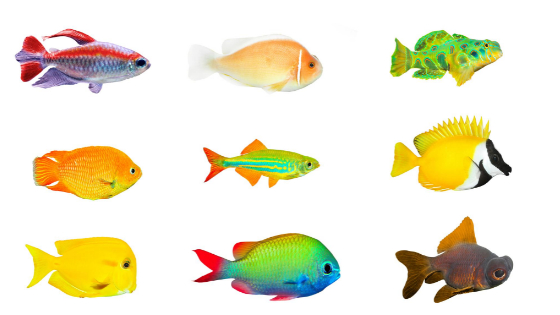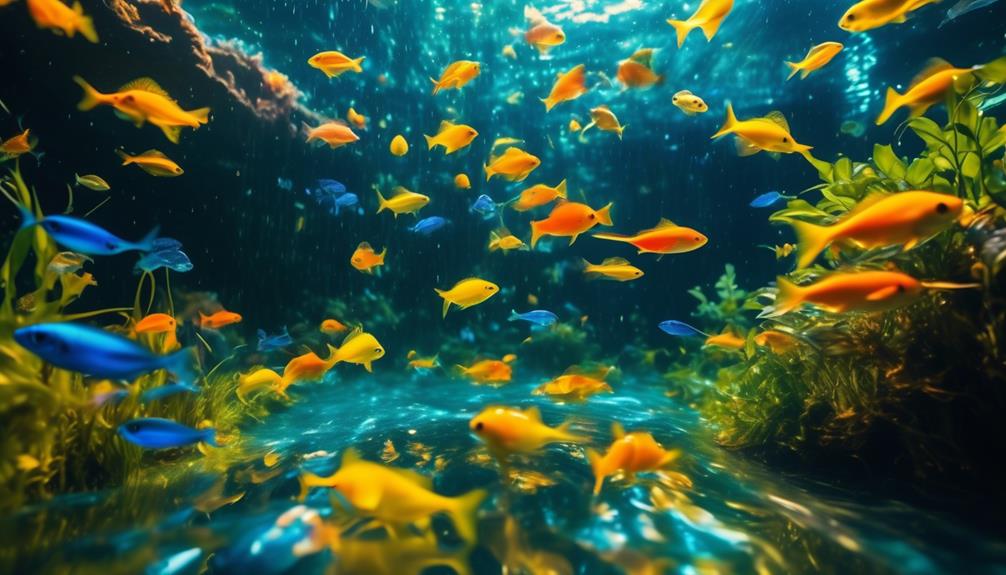
Are you ready to dive into the enchanting world of colorful and playful platies?
These captivating freshwater fish are like a burst of sunshine in your aquarium, bringing life and vibrancy to your underwater haven.
But there's more to discover beyond their stunning appearance.
From their fascinating behavior to their easy feeding requirements, platies have a lot to offer.
So, prepare yourself for a journey into the realm of these delightful creatures, as we uncover the secrets of creating the perfect habitat for these lively and captivating freshwater fish.
Key Takeaways
- Platies are small, colorful freshwater fish that are suitable for small to medium-sized aquariums and ideal for hobbyists with limited space.
- They have a peaceful nature and get along well with other fish, making them great additions to community tanks.
- Platies are active swimmers and prefer to be kept in schools, so it's recommended to have multiple platies in the aquarium.
- They are easy to care for and easy to breed in home aquariums, making them a popular choice for beginner fishkeepers.
General Information
Platies, as freshwater fish, are small in size and are perfect for small to medium-sized aquariums. They're ideal for hobbyists who've limited space but still want to enjoy the beauty of a vibrant aquarium. These fish are easy to care for, requiring only weekly maintenance.
They're known for their peaceful nature and get along well with other fish, making them suitable for community tanks. Platies are active swimmers, constantly exploring their surroundings and engaging in social interactions. They prefer to be in groups, so it's recommended to keep them in schools.
Breeding platies is relatively easy, as they can reproduce easily in a home aquarium. Overall, platies are a great addition to any aquarium, providing color, movement, and enjoyment.
Appearance
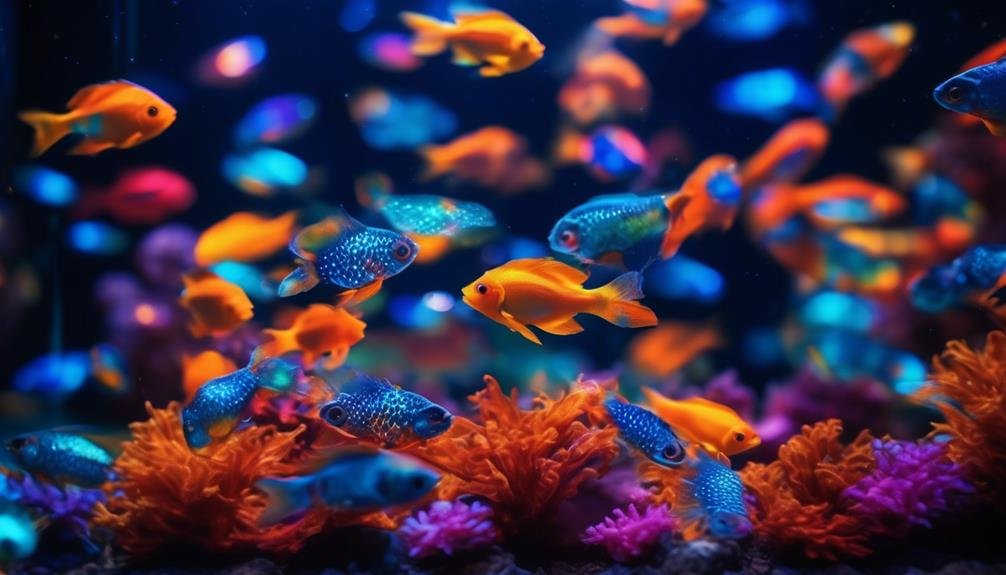
Their compact body shape and vibrant, flowing fins make platies visually striking in any aquarium. These small freshwater fish come in a wide array of colors, including red, orange, yellow, blue, and black.
Their short and compact body shape allows them to easily navigate through plants and decorations, adding a playful touch to the tank. The fins of platies are a standout feature, with their vibrant hues and graceful movement as they swim. Additionally, platies have varied tail shapes, ranging from fan-shaped to lyre-shaped, adding further visual interest. Some platies also have unique patterns and markings on their bodies, making each individual fish truly one-of-a-kind.
With their eye-catching appearance, platies are sure to be the focal point of any aquarium.
Behavior
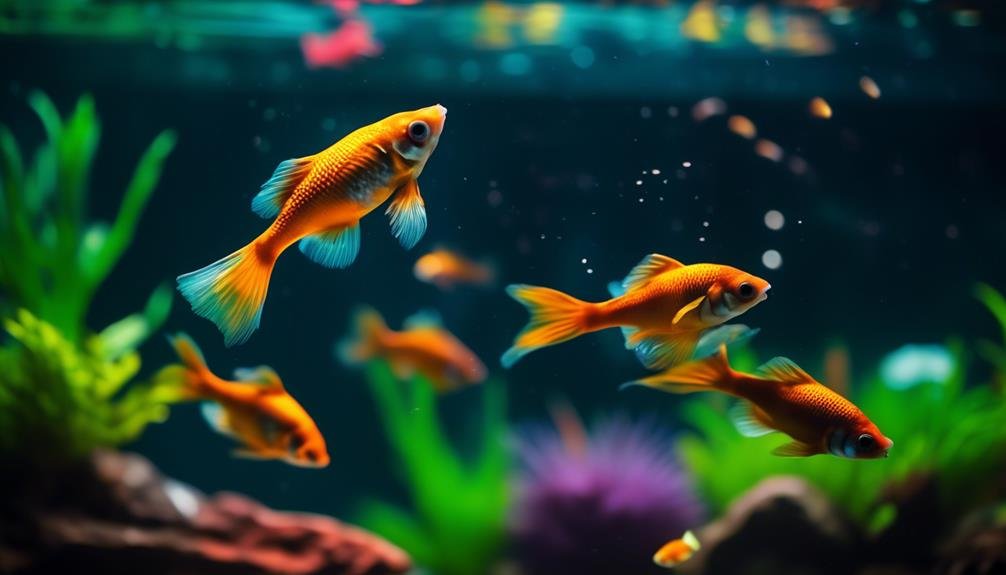
Platies are known for their peaceful and active behavior in the aquarium. These vibrant freshwater fish get along well with other fish and are constantly swimming and exploring their environment. They're playful and engage in social interactions, making them a joy to watch.
Platies prefer to be in groups, so it's recommended to keep them in schools. Breeding is also relatively easy for platies, as they can reproduce easily in the aquarium.
When it comes to feeding, platies are omnivorous and require a balanced diet. They can be fed pellets, flakes, and live or frozen food, with a feeding frequency of 2-3 times a day. However, be cautious not to overfeed them, as it can lead to health issues.
Feeding
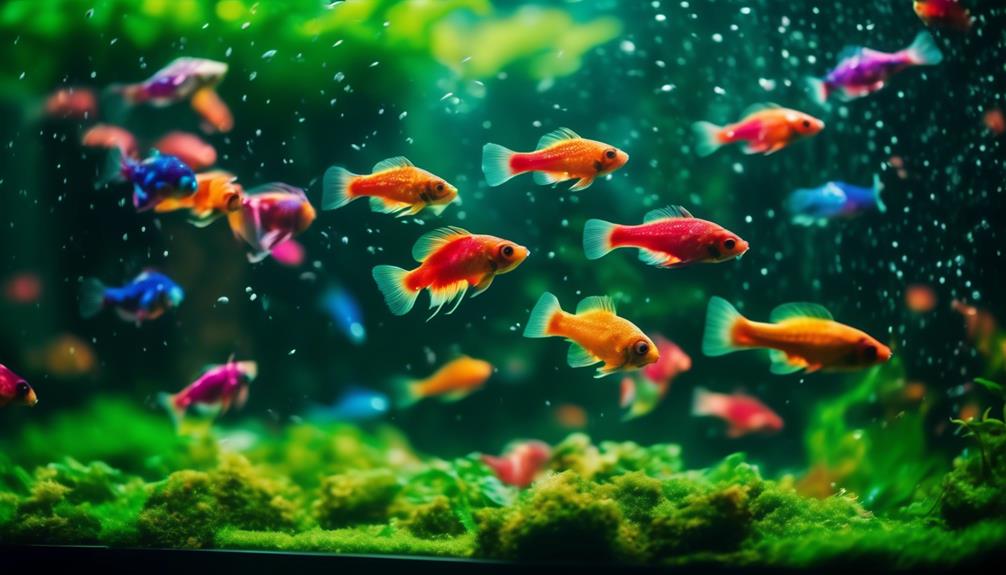
To ensure the health and well-being of your platies, it's important to provide them with a balanced diet. Here are some key points to consider when feeding your platies:
- Offer a variety of food types such as pellets, flakes, and live or frozen food.
- Feed your platies 2-3 times a day, giving them small portions that they can consume within a few minutes.
- Avoid overfeeding, as it can lead to health issues and water quality problems in the tank.
- Remember that platies are omnivorous, so their diet should include both plant matter and small organisms.
Tank Requirements
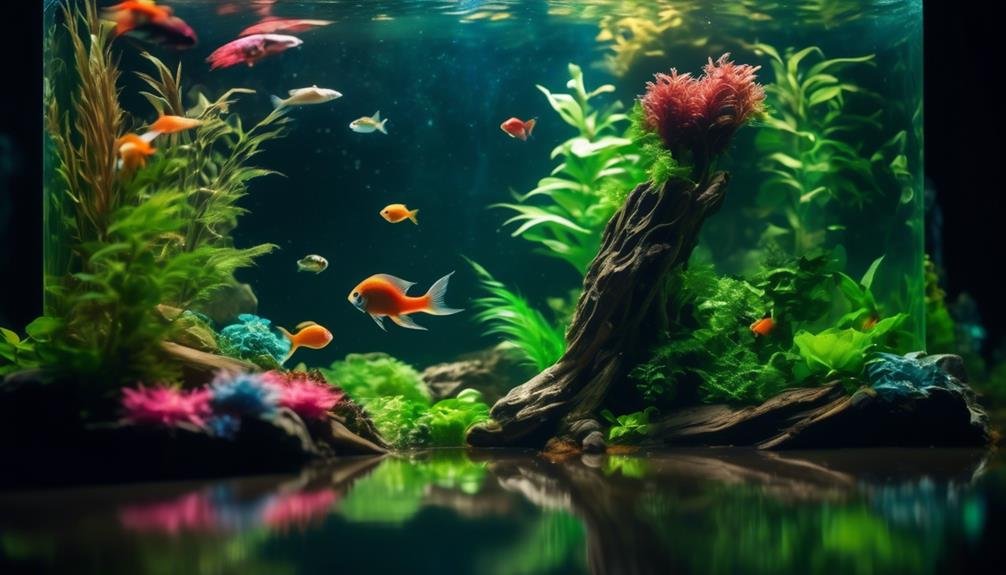
When setting up a tank for platies, it's important to consider their specific requirements. Platies require a minimum tank size of 10 gallons to thrive.
It's crucial to maintain a water temperature between 72-82°F (22-28°C) and ensure the water parameters are neutral to slightly alkaline pH.
An efficient filtration system is necessary to keep the water clean and healthy for the platies.
Additionally, providing hiding spots and plants in the tank will make them feel secure and comfortable.
These colorful and playful fish enjoy exploring their surroundings, so it's essential to create an environment that allows for plenty of swimming space.
Tank Size
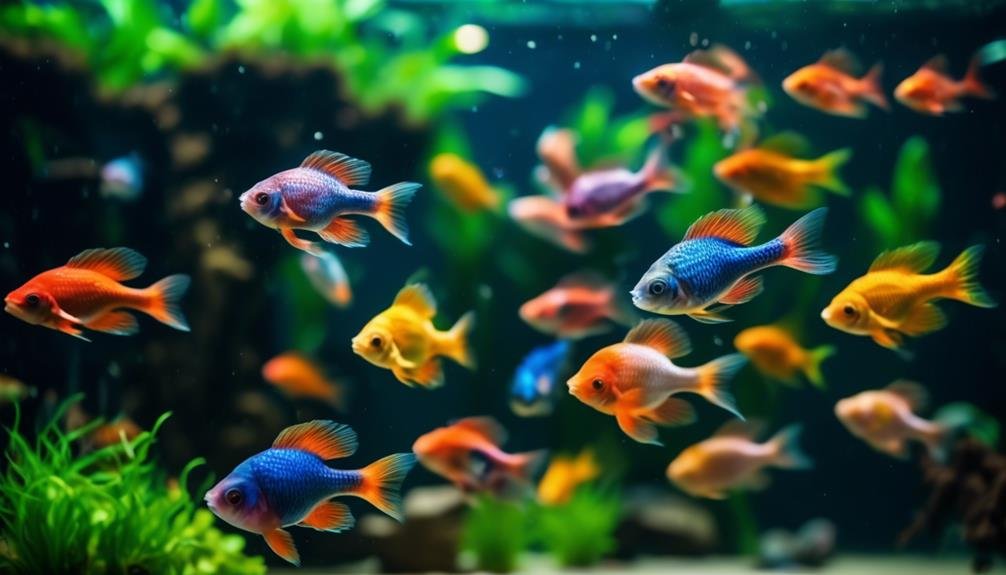
Consider the appropriate size for your tank when housing platies. To ensure the comfort and well-being of your platies, it's important to provide them with a tank that suits their needs. Here are some key factors to keep in mind:
- Tank size: A minimum tank size of 10 gallons is recommended for platies. This will provide them with enough space to swim around and explore.
- Swimming area: Platies are mid-range swimmers, so make sure to provide them with enough horizontal swimming space.
- Hiding spots: Create hiding spots and incorporate plants in the tank to give your platies a sense of security and privacy.
- Tank mates: Consider the number and size of tank mates when determining the appropriate tank size. Ensure there's enough space for all the fish to coexist peacefully.
Water Temperature
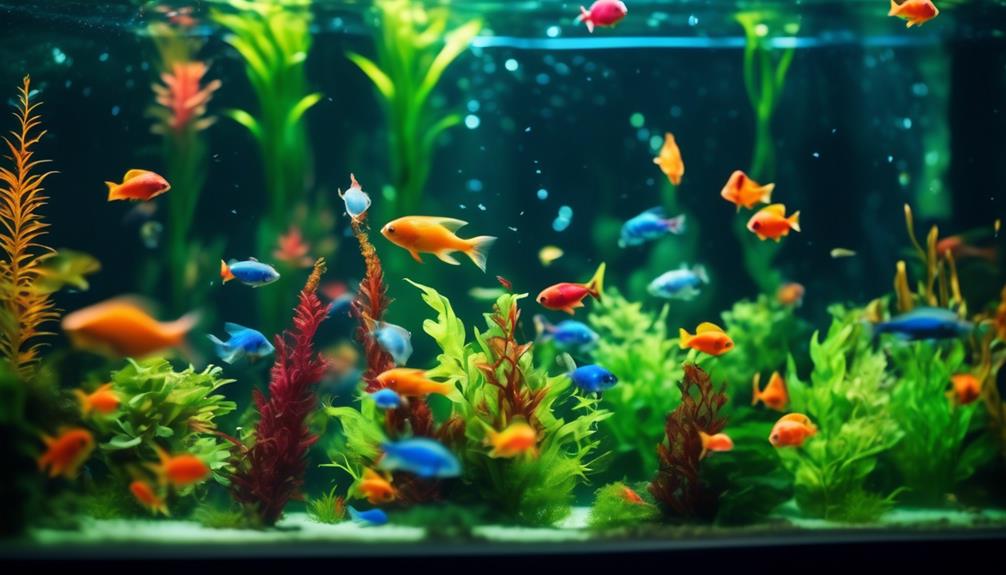
With your platies settled into their appropriately sized tank, let's now focus on ensuring the ideal water temperature for their optimal health and well-being. Platies thrive in water temperatures ranging from 72-82°F (22-28°C). Maintaining a stable temperature within this range is crucial for their overall well-being. Fluctuations in temperature can lead to stress and make your platies more susceptible to diseases. To help you monitor and regulate the water temperature, here's a table outlining the recommended temperature range and the potential effects of temperature extremes on your platies:
| Water Temperature Range | Effects on Platies |
|---|---|
| 72-76°F (22-24°C) | Optimal |
| 77-78°F (25-26°C) | Ideal for breeding |
| 79-82°F (26-28°C) | Stressful |
Water Parameters
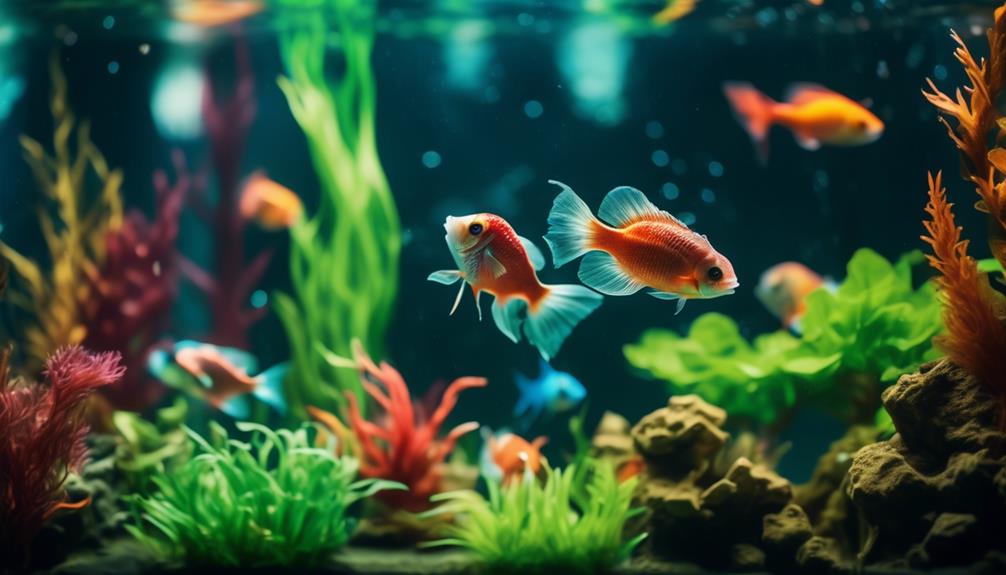
To ensure the optimal health and well-being of your platies, it's important to maintain appropriate water parameters in your aquarium. Here are four key factors to consider:
- pH level: Keep the water pH level in the range of 7.0 to 8.0, which is neutral to slightly alkaline. This will provide a suitable environment for your platies.
- Water hardness: Maintain a moderate water hardness level, around 10 to 25 dGH. This will mimic the natural conditions that platies thrive in.
- Ammonia and nitrate levels: Regularly test and monitor these levels to ensure they stay at safe levels. High levels of ammonia and nitrate can be harmful to your platies.
- Temperature: Maintain a water temperature between 72-82°F (22-28°C). This range will keep your platies comfortable and help them thrive.
Filtration and Decorations
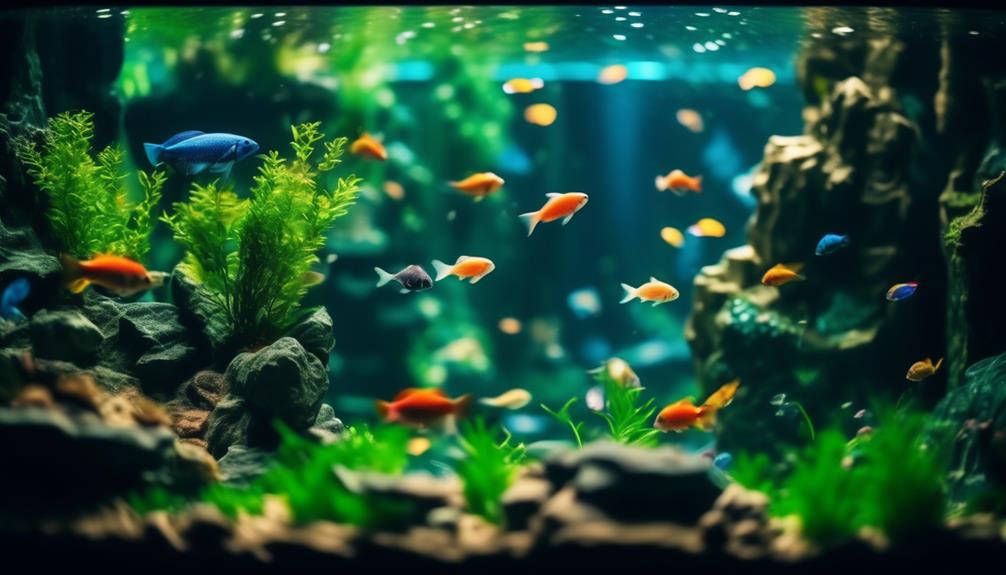
Now let's shift our focus to the important aspects of filtration and decorations for your platies' tank.
When it comes to filtration, it's crucial to have an efficient system that can maintain the water quality. Platies produce waste, and a good filtration system will help remove any toxins and maintain clean water. Look for a filter that's suitable for a small to medium-sized aquarium and has the capacity to handle the waste produced by your platies.
Additionally, decorations play a vital role in creating a stimulating and comfortable environment for your fish. Provide hiding spots and plants to mimic their natural habitat and to give them a sense of security. Plants also help to oxygenate the water and provide a natural filtration. Consider adding colorful ornaments and rocks to enhance the aesthetics of the tank while keeping the platies entertained.
Frequently Asked Questions
Can Platies Be Kept With Aggressive Fish Species?
Platies are generally peaceful fish, but it's not recommended to keep them with aggressive species. They prefer to be in groups with other peaceful fish, so it's best to choose tankmates accordingly.
How Often Should Platies Be Fed Live or Frozen Food?
You should feed your platies live or frozen food 2-3 times a day. It's important to provide a balanced diet, including pellets and flakes as well. Be careful not to overfeed, as it can lead to health issues.
Are Platies Prone to Any Specific Health Issues?
Platies are generally healthy fish, but they can be prone to specific health issues like fin rot and ich. It's important to maintain proper water conditions, provide a balanced diet, and closely monitor their overall health.
Do Platies Require a Specific Water Flow Rate in Their Tank?
No, platies don't require a specific water flow rate in their tank. They are adaptable freshwater fish that can thrive in various conditions. Just make sure to provide efficient filtration for maintaining water quality.
Can Platies Tolerate High Levels of Ammonia in the Water?
Platies cannot tolerate high levels of ammonia in the water. It is important to maintain proper water parameters and regularly test for ammonia to ensure the health and well-being of your platies.
Are Plecostomus Compatible with Colorful and Playful Platies in a Freshwater Aquarium?
The fascinating world of plecostomus is a great addition to a freshwater aquarium and can coexist well with colorful and playful platies. Plecos are peaceful bottom-dwellers, while platies are active swimmers. Just make sure the tank is spacious enough to accommodate both, and provide plenty of hiding spots for the plecostomus.
Conclusion
In conclusion, platies are a vibrant and lively addition to any freshwater aquarium. With their stunning colors, playful behavior, and easy care requirements, they're perfect for aquarium enthusiasts of all levels.
From their flowing fins to their social nature, platies are sure to bring joy to any tank. Just remember to provide them with a suitable tank size, balanced diet, and a comfortable environment.
So why wait? Add some colorful and playful platies to your freshwater aquarium today!




